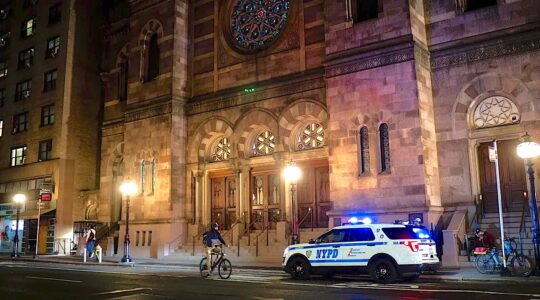T here’s an art to marriage — quite literally so, when it comes to the decorative art of the Jewish marriage contract, known in Hebrew as the ketubah.
And there’s no better way to understand the sumptuous history — and contemporary popularity — of the ketubah than by taking a tour of two rooms, at two different museums, but each one with the same single subject in common: the document that legally and ritually binds bride and groom together according to Jewish law and tradition. Not coincidentally, these rooms also demonstrate another kind of union: The fact that the ketubah itself through the ages has come to wed functional utility (the ketubah’s text clearly lays out the groom’s obligations, financial and otherwise, to the bride, to protect her in case of divorce or widowhood) with creative artistry.
Begin with the strikingly varied ketubot on display at The Jewish Museum here, where the exhibition, “The Art of Matrimony: Thirty Splendid Marriage Contracts from the Jewish Theological Seminary Library,” opened earlier this month. (We’ll get to the second room, the so-called “Ketubah Gallery” at the gift shop of the National Museum of American Jewish History in Philadelphia, a bit later.)
The 30 dazzling ketubot on view at The Jewish Museum — chosen from among the more than 600 in the JTS Library collection — are as diverse as the Jewish diaspora. They date from the 12th to the 21st centuries, and originate from such far-flung locales as Renaissance Europe, 12th-century Egypt, and contemporary America, as well as from India, Iraq, Iran, Morocco, Persia, Syria, and Turkey. They reveal artistic influences ranging from the traditional scribal arts of the Middle East to the ornate bird and floral designs of the Italian Renaissance, to the geometric patterns common to Islamic countries. Brightly ornamented borders often coexist with playful folk motifs. Signs of the Zodiac appear (commonplace in countries that follow the lunar calendar, and suggestive of good wishes as in the saying, “may the stars align”), as do miniature images depicting scenes from the Bible (often referencing the name of the bride or groom, as in the miniature of a scene from the life of Moses in a 1749 Manuta ketubah for a groom whose name was — well — Moses).
The earliest known Jewish marriage contract dates to the fifth century BCE, to the Ancient Egyptian area of Elphantine, explains Sharon Liberman Mintz, curator of Jewish Art at the JTS Library, as well as curator of the current Jewish Museum exhibition. Perhaps fittingly, then, the oldest example in the current exhibition also comes from Egypt — from the early 12th century CE. As if to demonstrate continuity amid change, this fragile fragment, which is scripted in ink and gold paint on parchment, with a scattering of simple geometric designs, echoes phrases found some 700 years later in a decidedly more elaborately decorated ketubah on display, this one from 1790 in Yemen. And so sumptuous are some Italian Renaissance designs that the same ketubah would be “re-used” by other couples; they would cut away the text in the center and paste in a new one, leaving those floridly intricate borders intact.
But whether from Rome, or Venice, or the Middle East, ketubot generally reflected the artistic styles as well as the folklore popular to that particular time and place. Look for love knots symbolizing eternal, unending love in examples from the Italian states and their trade partners; those fish swimming in the middle of the example from 19th-century Calcutta, India, represent a wish for fertility — and a hex against the evil eye. A boldly colored ketubah with Islamic-style arches, from 19th-century Herat, Afghanistan, is reminiscent of the local architecture, and the home the happy couple will soon inhabit. From Morocco, in 1896, comes a ketubah whose heart-shape motif harks back to the community’s origins as exiles from pre-Inquisition Spain: hands posed in benediction double as protective hamsas.
Don’t miss the 1863 ink and watercolor folk art ketubah from New York, which features a firm Yankee-style handshake and two clock towers pointing to the exact time of 6:13, no doubt a reference to the 613 commandments contained in the Bible. And fund-raisers might take note of the 1930s border that urges, “Remember the Jewish National Fund on the day of Your Wedding.”
Yet as charming, elegant and at times extravagant as these lovingly crafted ketubot of marriages past are, unlike ketubah art today, none of these historic examples was created to be displayed on the walls of the happy couple’s home, explains Mintz. Instead, the brides and grooms named in these classic vintage ketubot displayed their marriage contracts only once — when they were read out loud in public at the wedding ceremonies themselves — after which they were folded up and put away out of sight for safe-keeping, much as you would do with any important legal document. Indeed, so much was the ketubah considered the possession of the bride that in the Jewish community of Akhaltskihe, in Georgia, the ketubah would be buried with her body — which makes the example shown here so rare.
That may surprise many engaged couples today who have come to view (and shop for) a ketubah as an art work that not only celebrates their union but that also serves to decorate their household. That’s a contemporary custom that has caught on only since the 1970s, says noted ketubah artist Betsy Platkin Teutsch, who calls herself “one of the grandmothers of the ketubah Renaissance.” She remembers snapping up a copy of “The Jewish Catalogue” when it first came out in 1973 and using its chapters on Hebrew calligraphy and ketubot as how-to-do-it guides for her own early efforts. In the decades since, she has seen the market blossom and proliferate, and not just for her own ketubot, the most popular of which feature a “Tree of Life” motif, with two trees that intertwine to form an arch reminiscent of a bridal chupah.
Today, couples can select the ketubah that speaks to their own tastes from any number of design possibilities shown in virtual galleries all over the Internet (ketubah.com and judaiacconnection.com, among others). But perhaps most suggestive of the contemporary ketubah-as-artwork phenomenon is that second room referred to above — the so-called “Ketubah Gallery” at the gift shop of the National Museum of American Jewish History in Philadelphia.
“It’s a serene room, out of the fray” from the rest of the shop, where couples can concentrate on choosing a “monumental milestone marker that is probably the most symbolic memento of your wedding you could have, other than a photo,” says Kristen Kreider, director of retail operations at NMAJH. Designs using papercuts are among the most popular right now, she says, with couples today also choosing ketubot that are contemporary, more abstract, larger, and with brighter colors. Couples can choose from any number of texts, too, from traditional to egalitarian to interfaith and even same sex. You can even get a ketubah if you’re already married, in the form of the increasingly popular anniversary ketubah.
Says Teutsch: “When a Jewish museum gift shop devotes an entire room to consulting about and selling ketubot, it means that as a ritual object this is right up there next to the Kiddush cup.”
Support the New York Jewish Week
Our nonprofit newsroom depends on readers like you. Make a donation now to support independent Jewish journalism in New York.
Diane Cole is the author of the memoir “After
Great Pain: A New Life Emerges,” and a frequent contributor to many publications.
The New York Jewish Week brings you the stories behind the headlines, keeping you connected to Jewish life in New York. Help sustain the reporting you trust by donating today.




